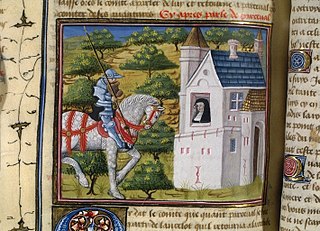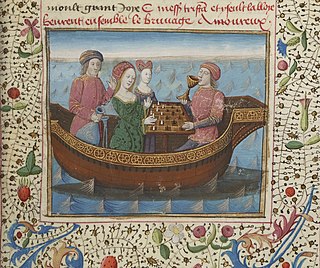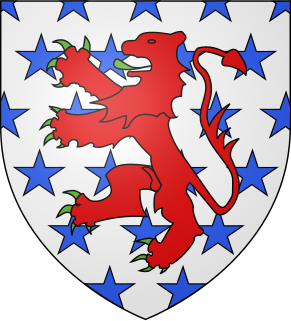Related Research Articles

Camelot is a castle and court associated with the legendary King Arthur. Absent in the early Arthurian material, Camelot first appeared in 12th-century French romances and, since the Lancelot-Grail cycle, eventually came to be described as the fantastic capital of Arthur's realm and a symbol of the Arthurian world.

Excalibur is the legendary sword of King Arthur, sometimes also attributed with magical powers or associated with the rightful sovereignty of Britain. It was associated with the Arthurian legend very early on. Excalibur and the Sword in the Stone are in some versions said to be different, though in most incarnations they are the same. In Welsh, it is called Caledfwlch; in Cornish, Calesvol ; in Breton, Kaledvoulc'h; and in Latin, Caliburnus. Several similar swords and other weapons also appear in this and other legends.

King Arthur was a legendary British leader who, according to medieval histories and romances, led the defence of Britain against Saxon invaders in the late 5th and early 6th centuries. The details of Arthur's story are mainly composed of Welsh and English folklore and literary invention, and modern historians generally agree that he is unhistorical. The sparse historical background of Arthur is gleaned from various sources, including the Annales Cambriae, the Historia Brittonum, and the writings of Gildas. Arthur's name also occurs in early poetic sources such as Y Gododdin.

The Round Table is King Arthur's famed table in the Arthurian legend, around which he and his knights congregate. As its name suggests, it has no head, implying that everyone who sits there has equal status. The table was first described in 1155 by Wace, who relied on previous depictions of Arthur's fabulous retinue. The symbolism of the Round Table developed over time; by the close of the 12th century it had come to represent the chivalric order associated with Arthur's court, the Knights of the Round Table.

Lancelot du Lac, also written as Launcelot and other variants, is a character in some versions of Arthurian legend, where he is typically depicted as King Arthur's close companion and one of the greatest Knights of the Round Table. In the French-inspired Arthurian chivalric romance tradition, Lancelot is the orphaned son of King Ban of the lost kingdom of Benwick, raised in the fairy realm by the Lady of the Lake. A hero of many battles, quests and tournaments, and famed as a nearly unrivalled swordsman and jouster, Lancelot becomes the lord of the castle Joyous Gard and personal champion of Arthur's wife Queen Guinevere. But when his adulterous affair with Guinevere is discovered, it causes a civil war that is exploited by Mordred to end Arthur's kingdom.

Mordred or Modred is a figure who is variously portrayed in the British tradition. The earliest known mention of a possibly historical Medraut is in the Welsh chronicle Annales Cambriae, wherein he and Arthur are ambiguously associated with the Battle of Camlann in a brief entry for the year 537. His figure seemed to have been regarded positively in the early Welsh tradition and may have been related to that of Arthur's son.

The Knights of the Round Table are the knights in the fellowship of King Arthur in the literary cycle of the Matter of Britain, a French-derived branch of Arthurian legend, first appearing in literature in the mid-12th century. The Knights are an order dedicated to ensuring the peace of Arthur's kingdom following an early warring period, entrusted in later years to undergo a mystical quest for the Holy Grail. The Round Table at which they meet is a symbol of the equality of its members, who range from sovereign royals to minor nobles.

Sir Gareth is a Knight of the Round Table in Arthurian legend. He was the youngest son of King Lot and Queen Morgause, King Arthur's half-sister, thus making him Arthur's nephew, as well as brother to Gawain, Agravain, and Gaheris, and either a brother or half-brother of Mordred. He is particularly notable in Le Morte d'Arthur where he is also known by his nickname Beaumains.

Gaheris is a knight of the Round Table in the chivalric romance tradition of Arthurian legend. A nephew of King Arthur, Gaheris is the third son of Arthur's sister or half-sister Morgause and her husband Lot, King of Orkney and Lothian. He is the younger brother of Gawain and Agravain, the older brother of Gareth, and half-brother of Mordred.
Robert de Boron was a French poet of the late 12th and early 13th centuries, notable as the reputed author of the poems Joseph d'Arimathie and Merlin. Although little is known of him apart from the poems he allegedly wrote, his works and subsequent prose redactions of them had a strong influence on later incarnations of the Arthurian legend and its prose cycles, particularly through their Christian back story for the Holy Grail.

Sir Agravain is a Knight of the Round Table in Arthurian legend, whose first known appearance is in the works of Chrétien de Troyes. He is the second eldest son of King Lot of Orkney with one of King Arthur's sisters known as Anna or Morgause, thus nephew of King Arthur, and brother to Sir Gawain, Gaheris, and Gareth, as well as half-brother to Mordred. Agravain secretly makes attempts on the life of his hated brother Gaheris since the Vulgate Cycle, participates in the slayings of Lamorak and Palamedes in the Post-Vulgate Cycle, and murders Dinadan in the Prose Tristan. In the French prose cycle tradition included in Thomas Malory's Le Morte d'Arthur, together with Mordred, he then plays a leading role by exposing his aunt Guinevere's affair with Lancelot, which leads to his death at the hands of Lancelot.

The Lancelot-Grail, also known as the Vulgate Cycle or the Pseudo-Map Cycle, is an early 13th-century French Arthurian literary cycle consisting of interconnected prose episodes of chivalric romance in Old French. The cycle of unknown authorship, presenting itself as a chronicle of actual events, retells the legend of King Arthur by focusing on the love affair between Lancelot and Guinevere as well as the quest for the Holy Grail, expanding on the works of Robert de Boron and Chrétien de Troyes and influencing the Prose Tristan. After its completion around 1230–1235, the Lancelot–Grail was soon followed by its major rewrite known as the Post-Vulgate Cycle. Together, the two cycles constituted a highly influential and most widespread form of Arthurian romance literature during their time and also contributed the most to the later English compilation Le Morte d'Arthur that formed the basis for the legend's modern canon.

Perceval, the Story of the Grail is the unfinished fifth verse romance by Chrétien de Troyes, written by him in Old French in the late 12th century. Later authors added 54,000 more lines in what are known collectively as the Four Continuations, as well as other related texts. Perceval is the earliest recorded account of what was to become the Quest for the Holy Grail but describes only a golden grail in the central scene, does not call it "holy" and treats a lance, appearing at the same time, as equally significant.

The Post-Vulgate Cycle, also known as the Post-Vulgate Arthuriad, the Post-Vulgate Roman du Graal or the Pseudo-Robert de Boron Cycle, is one of the major Old French prose cycles of Arthurian literature from the early 13th century. It is considered essentially a shortened rewriting of the earlier Vulgate Cycle, with much left out but also much added, including characters and scenes from the Prose Tristan.
Sarras is a mystical island to which the Holy Grail is brought in the Arthurian legend. In the Lancelot-Grail Cycle, Joseph of Arimathea and his followers visit the island on their way to Britain; while there Joseph's son Josephus is invested as a bishop and shown the mysteries of the Grail by Christ himself. The party wins many converts, and moves on to Britain where they establish a great line of kings. After they achieve the Grail the knights Galahad, Percival, and Bors return the object to Sarras aboard Solomon's ship, but they find the residents fallen back to paganism. The Grail knights restore the people's faith and preside over them benevolently for a year, but Galahad dies in ecstasy when the Grail is taken to Heaven by God, and Percival follows him shortly after. Bors returns to Arthur's kingdom to tell the tale.

The Prose Tristan is an adaptation of the Tristan and Iseult story into a long prose romance, and the first to tie the subject entirely into the arc of the Arthurian legend. It was also the first major Arthurian prose cycle commenced after the widely popular Lancelot-Grail, which influenced especially the later portions of the Prose Tristan.
Perlesvaus, also called Li Hauz Livres du Graal, is an Old French Arthurian romance dating to the first decade of the 13th century. It purports to be a continuation of Chrétien de Troyes' unfinished Perceval, the Story of the Grail, but it has been called the least canonical Arthurian tale because of its striking differences from other versions.

Galehaut is a very tall knight in the Arthurian legend. He is most prominent within the Lancelot-Grail prose cycle where he is a noble enemy turned an ally of King Arthur as well as an inseparable friend of Arthur's champion Lancelot. The figure of Galehaut should not be mistaken with Lancelot's son, Galahad, and some other similarly named characters.

Merlin is a partly lost French epic poem written by Robert de Boron in Old French and dating from either end of the 12th or beginning of the 13th century. The author reworked Geoffrey of Monmouth's material on the legendary Merlin, emphasising Merlin's power to prophesy and linking him to the Holy Grail. The poem tells of his origin and early life, his role in the birth of Arthur, and how Arthur became King of Britain. Merlin's story relates to Robert's two other reputed Grail poems, Joseph and Perceval. It introduced motifs that became popular in medieval and later Arthuriana, ensuring him a lasting place in the legend of King Arthur.
Moriaen is a 13th-century Arthurian romance in Middle Dutch. A 4,720-line version is preserved in the vast Lancelot-Compilatie, and a short fragment exists at the Royal Library at Brussels. The work tells the story of Morien, the Moorish son of Aglovale, one of King Arthur's Knights of the Round Table.
References
- ↑ "NORRIS J. LACY". Pennsylvania State University. Retrieved 4 August 2016.
The first full English translations of the Vulgate and Post-Vulgate Cycles were overseen by Norris J. Lacy. Volumes 1–4 contain the Vulgate Cycle proper.
- Lacy, Norris J. (Ed.). Lancelot–Grail: The Old French Arthurian Vulgate and Post-Vulgate in Translation, New York: Garland.
- Volume 1 of 5 (December 1, 1992). ISBN 0-8240-7733-4.
- Volume 2 of 5 (August 1, 1993). ISBN 0-8153-0746-2.
- Volume 3 of 5 (March 1, 1995). ISBN 0-8153-0747-0.
- Volume 4 of 5 (April 1, 1995). ISBN 0-8153-0748-9.
- Volume 5 of 5 (May 1, 1996). ISBN 0-8153-0757-8.
- Lacy, Norris J. (Ed.) (2000). The Lancelot–Grail Reader. New York: Garland. ISBN 0-8153-3419-2.